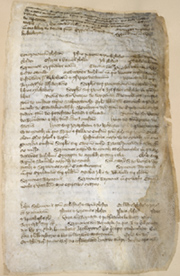 |
 |
 |
 |
 |
 |
 |
|
Concessions (3/3) The Cistercians later adopted a more flexible attitude and individual abbeys might negotiate reasonable concessions to give more women greater access to their churches. A particularly striking example relates to the Yorkshire abbey of Meaux. In c. 1339 the General Chapter conceded that men and women of honest character might enter the monks’ church at Meaux to view a crucifix in the lay-brothers’ choir, which had recently been commissioned by Abbot Hugh (1339-1349), and was reputedly working miracles. Under no circumstance, however, were women to enter the dormitory, cloister or any of the other buildings. An exception was made for the patron’s wife and daughter, but even they were not permitted to stay the night within the precinct, to enter the precinct before Prime or to remain after Compline. If any of these terms was breached, the entire privilege would be withdrawn. This concession turned out to be something of a poisoned chalice, for the monks were overwhelmed by the hoards of women who flocked to visit their church not, as was noted, from great devotion, but out of nosiness and to indulge in the hospitality of the house. No doubt the fact that the crucifix had been carved from a naked model was an added incentive to these women! (11)
By the fifteenth century there were less rigid rules. In 1401 the abbot of Kirkstall Abbey, in Yorkshire, was notified of a papal receipt permitting women to enter his church on those days when access was given to men, although they were forbidden from entering any of the other buildings.(12) In 1437 it was agreed that no woman should stay the night within the precinct of the royal abbey of Hailes, but an exception was made for the monks’ mothers and sisters who had travelled a long distance to visit. If any monk of the house wished to speak with a female he had to do so in the hall, in the presence of the prior or his deputy; any monk who introduced women ‘in suspicious circumstances ’ would be excommunicated.(13) |
|||
|
